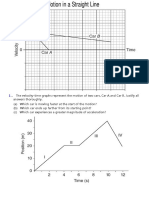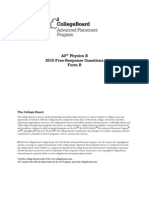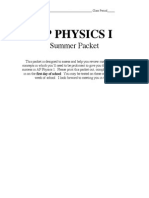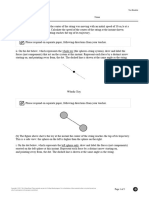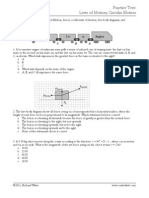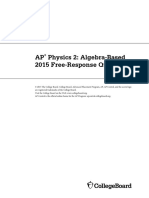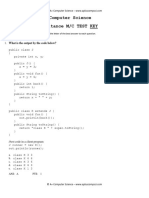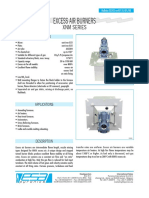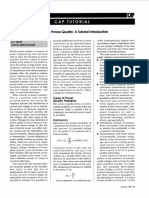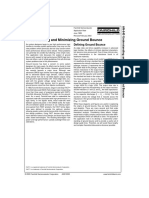Physics Honors Chapter 2 Practice Test
Uploaded by
Aref DahabrahPhysics Honors Chapter 2 Practice Test
Uploaded by
Aref DahabrahlOMoARcPSD|8371411
Physics Honors Chapter 2 Practice Test
Physics For Scientists And Engineers I (University of Nevada, Las Vegas)
StuDocu is not sponsored or endorsed by any college or university
Downloaded by brave mernda (us1212@yahoo.com)
lOMoARcPSD|8371411
Name:
Honors Physics Chapter 2 Test
____ 1. What is the speed of an object at rest?
0 m/s
2. What is the equation for average velocity?
change in displacement/time
3. Explain what is happening in situations that have a negative displacement? (Assume positive position is
measured vertically upward along a y-axis.)
When something has negative displacement, it has gone backwards that amount of distance. In relation to a graph,
negative displacement would be negative on the y-axis.
4. What is the SI unit of velocity?
m/s (meters/second)
5. What is the difference between distance and displacement? Distance is the total amount of ground traveled during its
motion, while displacement is the difference in distance in
relation to the starting point (object's overall change in
position)
6. Describe the motion of the cat in relation to its displacement.
The cat starts off 2 meters north of its starting point, then after 5 seconds it walks north increasing the displacement to 3 meters, then stays there
until 10 seconds then starts going south back towards the starting point until it is 0.5 meters from the starting point.
7. Describe the motion of the cat in relation to its velocity.
The cat starts at 0 velocity, then starts speeding up until 5 seconds, then stays still until 10 seconds, then slows down and goes back to the
starting point until it is 0.5 meters away from the starting point.
____ 8. What is the difference between speed and velocity?
Speed is the distance traveled divided by the time elapsed, while velocity is the speed of an object with a direction.
9. What is the equation for acceleration?
a=(change in velocity)/(time) (m/s/s)
10. What is the SI unit of acceleration?
m/s2
Downloaded by brave mernda (us1212@yahoo.com)
lOMoARcPSD|8371411
11. When a car’s velocity is positive and its acceleration is negative, what is happening to the car’s motion?
The motion of the car is slowing down while moving forward.
12. When a car’s velocity is negative and its acceleration is negative, what is happening to the car’s motion?
The motion of the car is speeding up while moving backwards.
free
13. Acceleration due to gravity is also called _____________ fall
_______________.
14. Describe what happens to the velocity of a ball as it is thrown straight up and then falls back to its original
position. The velocity of the ball when thrown up is the highest when it is first thrown then slows down until it reaches its peak, which has
zero velocity, then falls back down and accelerates back down until its original position, where velocity is the lowest.
15. Which would hit the ground first if dropped from the same height in a vacuum—a feather or a metal bolt?
The feather and the metal bolt would hit the ground at the same time since there is no air resistance in a vacuum.
Problems
1. A shopping cart is given an initial velocity of 2.0 m/s and undergoes a constant acceleration of 3.0 m/s 2. What
is the magnitude of the cart’s displacement after the first 6.0 s of its motion?
66 meters
2. A skater glides off a frozen pond onto a patch of ground at a speed of 2.2 m/s. Here she is slowed at a
constant rate of 3.00 m/s2. How fast is the skater moving when she has slid 0.25 m across the ground?
1.83m/s
3. A toy car is given an initial velocity of 6.0 m/s and experiences a constant acceleration of 3.5 m/s2. What is
the final velocity after 5.2 s?
24.2 m/s
4. A coin released at rest from the top of a tower hits the ground after falling 2.3 s. What is the speed of the coin
as it hits the ground? (Disregard air resistance. a = −g = −9.8 m/s2.)
-22.54m/s
5. A rock is thrown downward from the top of a cliff with an initial speed of 16 m/s. If the rock hits the ground
after 4.5 s, what is the height of the cliff? (Disregard air resistance. a = −g = −9.8 m/s2.)
171.225 meters
Downloaded by brave mernda (us1212@yahoo.com)
You might also like
- Safety Distance: Rules For Pressure Testing Lloyds Register (96-02)67% (6)Safety Distance: Rules For Pressure Testing Lloyds Register (96-02)2 pages
- Essentials of The Living World 5th Edition George Johnson Solutions ManualNo ratings yetEssentials of The Living World 5th Edition George Johnson Solutions Manual4 pages
- Psyche and Singularity - Timothy DesmondNo ratings yetPsyche and Singularity - Timothy Desmond366 pages
- The Velocity-Time Graphs Represent The Motion of Two Cars, Car A and Car B. Justify AllNo ratings yetThe Velocity-Time Graphs Represent The Motion of Two Cars, Car A and Car B. Justify All5 pages
- AP Physics 1 Unit 1 Test Review Answers 1ezrmkfNo ratings yetAP Physics 1 Unit 1 Test Review Answers 1ezrmkf5 pages
- AP Physics C Mechanics Sample Syllabus 1No ratings yetAP Physics C Mechanics Sample Syllabus 19 pages
- Tarea #3: Difusión en Estado Estacionario y Pseudoestacionario Sin Reacción QuímicaNo ratings yetTarea #3: Difusión en Estado Estacionario y Pseudoestacionario Sin Reacción Química8 pages
- ap-physics-c-em-practice-exam-2012 test만 (3월 18일)No ratings yetap-physics-c-em-practice-exam-2012 test만 (3월 18일)28 pages
- AP Physics 1 Algebra Based Unit 5 MomentumNo ratings yetAP Physics 1 Algebra Based Unit 5 Momentum7 pages
- AP Physics: Algebra Based - Study GuideNo ratings yetAP Physics: Algebra Based - Study Guide67 pages
- AP Physics 1: Algebra-Based: Free-Response QuestionsNo ratings yetAP Physics 1: Algebra-Based: Free-Response Questions11 pages
- Broward County Schools AP Physics 1 ReviewNo ratings yetBroward County Schools AP Physics 1 Review20 pages
- Practice Test-3-Laws of Motion-Circular MotionNo ratings yetPractice Test-3-Laws of Motion-Circular Motion14 pages
- Session 3 Physics C Mechanics 2023 AP Daily Practice SessionsNo ratings yetSession 3 Physics C Mechanics 2023 AP Daily Practice Sessions1 page
- Ap Phys1 - Kinematics 2d Multiple Choice - 2023 10 07No ratings yetAp Phys1 - Kinematics 2d Multiple Choice - 2023 10 0714 pages
- Mahidol University International College: Mathematics Test SampleNo ratings yetMahidol University International College: Mathematics Test Sample16 pages
- AP Physics 1 2016 Scoring Guidelines: 12 Points Total Distribution of PointsNo ratings yetAP Physics 1 2016 Scoring Guidelines: 12 Points Total Distribution of Points10 pages
- TB PhysicsTestY3 654b29bcc38e07.654b29bed4No ratings yetTB PhysicsTestY3 654b29bcc38e07.654b29bed417 pages
- AP Physics 2: Algebra-Based 2015 Free-Response QuestionsNo ratings yetAP Physics 2: Algebra-Based 2015 Free-Response Questions11 pages
- ap-phys1_uniform-circular-motion-ap-free-response-problems_2024-11-22No ratings yetap-phys1_uniform-circular-motion-ap-free-response-problems_2024-11-2216 pages
- Circular & Gravitation AP Questions WorksheetNo ratings yetCircular & Gravitation AP Questions Worksheet17 pages
- AP Physics 1 - Unit 1: Kinematics in One and Two DimensionsNo ratings yetAP Physics 1 - Unit 1: Kinematics in One and Two Dimensions50 pages
- Table of Information and Equation Tables For AP Physics ExamsNo ratings yetTable of Information and Equation Tables For AP Physics Exams4 pages
- Web Review - CH 3 Motion in Two Dimensions Practice TestNo ratings yetWeb Review - CH 3 Motion in Two Dimensions Practice Test6 pages
- Section Quiz 3-2 - Schools of The Sacred HeartNo ratings yetSection Quiz 3-2 - Schools of The Sacred Heart3 pages
- Webreview CP Physics CH 3 Practice Test (Holt)No ratings yetWebreview CP Physics CH 3 Practice Test (Holt)8 pages
- Worksheet Free Falling - Phet Sim Hamza1No ratings yetWorksheet Free Falling - Phet Sim Hamza13 pages
- D Is Between C and E - CE 6x, CD 4x+8, and D E 27 - Find C ENo ratings yetD Is Between C and E - CE 6x, CD 4x+8, and D E 27 - Find C E20 pages
- 250-256!4!5 Isosceles and Equilateral Triangles100% (1)250-256!4!5 Isosceles and Equilateral Triangles7 pages
- Angle Realtionships in Triangles KEY POSTINGNo ratings yetAngle Realtionships in Triangles KEY POSTING4 pages
- 3a-Vlsi Lecture Transistors Wires Parasitics Chapter 3No ratings yet3a-Vlsi Lecture Transistors Wires Parasitics Chapter 3139 pages
- WEG Cfw500 Manual Do Usuario 10001278006 Manual Portugues BRNo ratings yetWEG Cfw500 Manual Do Usuario 10001278006 Manual Portugues BR150 pages
- PST MaxxShot Brochure Fina06th March EditlNo ratings yetPST MaxxShot Brochure Fina06th March Editl4 pages
- Electric Pow Uality: Tutorial Lntro: G.T. Heydt Arizona Sfufe UniversityNo ratings yetElectric Pow Uality: Tutorial Lntro: G.T. Heydt Arizona Sfufe University5 pages
- Geomechanics Applied To The Petroleum Industry100% (1)Geomechanics Applied To The Petroleum Industry180 pages
- Carbon Film / Metal Film Resistors: ResistorNo ratings yetCarbon Film / Metal Film Resistors: Resistor5 pages
- E-20 Load Heat Estimation Completada 07-01-17No ratings yetE-20 Load Heat Estimation Completada 07-01-1792 pages
- Pure Sine Wave Inverter User Manual: SP1500 SERIES/SP2000 SERIES SP2500 SERIES/SP3000 SERIESNo ratings yetPure Sine Wave Inverter User Manual: SP1500 SERIES/SP2000 SERIES SP2500 SERIES/SP3000 SERIES18 pages






